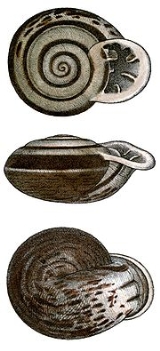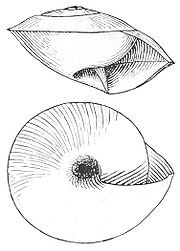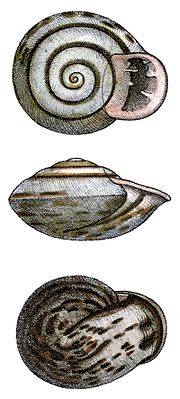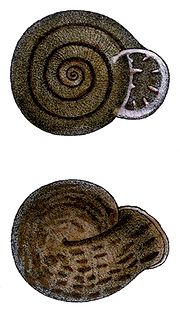
Anostoma
Encyclopedia
Anostoma, common name
the up-mouth snails, is a genus
of tropical air-breathing land snail
s, terrestrial
pulmonate gastropod mollusks in the subfamily Bulimulinae, in the family Orthalicidae
. Snails in this genus are found in Brazil
.
Adult snails in this genus have an extremely unusual shell
morphology: the aperture of the adult shell faces directly "upwards", in other words, in the same direction as the spire
. This seemingly impossible arrangement is made possible because the adult shell is carried upside down.
In 1901, the American malacologist Henry Augustus Pilsbry
commented that the adult shell of Anostoma is "so bizarre that in the total absence of information upon its life history, no useful theory can be formulated to account for its peculiarities."
A very similar shell is found in the genus Ringicella
Gray, 1847, which was previously considered to be merely a subgenus
within Anostoma, but it is now considered to be a genus in its own right.

 This is one of the most peculiar genera of land snails. The prominent feature of an upturned aperture (causing the adult snail to carry the shell spire down) is reflected in its scientific name Anostoma: ano, means up, or backwards, and stoma means mouth, from the Greek
This is one of the most peculiar genera of land snails. The prominent feature of an upturned aperture (causing the adult snail to carry the shell spire down) is reflected in its scientific name Anostoma: ano, means up, or backwards, and stoma means mouth, from the Greek
.
In this genus, the adult snails carry the shell completely upside down, with the umbilicus uppermost, and the spire facing downwards. To make this extraordinary feat possible, the mature aperture of the shell is aligned in the same plane as the rather low spire of the shell.
It appears that in juveniles, the shell is carried with the widest diameter vertically aligned, in other words, with the keel of the shell pointing up.
Thomas Wyatt (1838) wrote about Anostoma: "An extraordinary shell, sometimes called the antique lamp
from its form. Shell orbicular, the spire convex and obtuse; aperture round, toothed within, grinning, turned upward to the spire; margin reflected."
The shell of Anostoma is heliciform, biconvex, solid, the axis hollow, but imperforate in the adult stage. The shell is composed of few whorls
, the last straightened, turning toward the margin and upward.
Before the last half whorl is formed, the shell is umbilicate, and judging by the growth-lines, the juvenile and subadult shell is carried with the equatorial plane nearly vertical. However, as the last half whorl starts to form, the direction of growth changes: it tilts to the right, not to the left as in the Helicidae
, and subsequently that half whorl grows up across the base of the shell. The final aperture in the adult is slightly above the keel or widest diameter of the shell.
 The apex
The apex
of the shell is smooth and somewhat flattened. The peristome is expanded and reflexed.The semicircular aperture
is turned upward, obstructed by numerous lamellae and folds. In the aperture of Anostoma, the primitive condition of the parietal armature remains, the angular, parietal and infraparietal lamellae being all present and separate. In Anostoma the parietal lamella is the longest while in other Odontostomini the infraparietal lamella is the longest. The "teeth" of the aperture are entirely homologous with those of Odontostomus
.
The similar genus Ringicella
has an additional feature on its shell: the angular lamella and upper suprapalatal fold are concrescent and form a perforation in the lip at its upper end.
. At the time that species was described as an Anostoma, and Pilsbry (who was very thorough) did not make any comments that implied that there was any difference between the anatomy of that species and that of any of the other Anostoma species he examined. Thus, see Ringicella#Anatomy.
Anatomy of Anostoma depressum was examined by Harold Heath in 1914.
 Species within this genus include:
Species within this genus include:
Ringicella
is currently considered to be a genus in its own right. Species that are now in the genus Ringicella were previously included in the genus Anostoma.
Synonyms:
Common name
A common name of a taxon or organism is a name in general use within a community; it is often contrasted with the scientific name for the same organism...
the up-mouth snails, is a genus
Genus
In biology, a genus is a low-level taxonomic rank used in the biological classification of living and fossil organisms, which is an example of definition by genus and differentia...
of tropical air-breathing land snail
Snail
Snail is a common name applied to most of the members of the molluscan class Gastropoda that have coiled shells in the adult stage. When the word is used in its most general sense, it includes sea snails, land snails and freshwater snails. The word snail without any qualifier is however more often...
s, terrestrial
Terrestrial animal
Terrestrial animals are animals that live predominantly or entirely on land , as compared with aquatic animals, which live predominantly or entirely in the water , or amphibians, which rely on a combination of aquatic and terrestrial habitats...
pulmonate gastropod mollusks in the subfamily Bulimulinae, in the family Orthalicidae
Orthalicidae
Orthalicidae are a family of tropical air-breathing land snails, terrestrial pulmonate gastropod mollusks are classified in the informal group Sigmurethra of the clade Stylommatophora...
. Snails in this genus are found in Brazil
Brazil
Brazil , officially the Federative Republic of Brazil , is the largest country in South America. It is the world's fifth largest country, both by geographical area and by population with over 192 million people...
.
Adult snails in this genus have an extremely unusual shell
Gastropod shell
The gastropod shell is a shell which is part of the body of a gastropod or snail, one kind of mollusc. The gastropod shell is an external skeleton or exoskeleton, which serves not only for muscle attachment, but also for protection from predators and from mechanical damage...
morphology: the aperture of the adult shell faces directly "upwards", in other words, in the same direction as the spire
Spire (mollusc)
A spire is a descriptive term for part of the coiled shell of mollusks. The word is a convenient aid in describing shells, but it does not refer to a very precise part of shell anatomy: the spire consists of all of the whorls except for the body whorl...
. This seemingly impossible arrangement is made possible because the adult shell is carried upside down.
In 1901, the American malacologist Henry Augustus Pilsbry
Henry Augustus Pilsbry
Henry Augustus Pilsbry was an American biologist, malacologist and carcinologist, among other areas of study. He was a dominant presence in many fields of invertebrate taxonomy for the better part of a century...
commented that the adult shell of Anostoma is "so bizarre that in the total absence of information upon its life history, no useful theory can be formulated to account for its peculiarities."
A very similar shell is found in the genus Ringicella
Ringicella
Ringicella is a genus of tropical air-breathing land snails, terrestrial pulmonate gastropod mollusks in the subfamily Bulimulinae, in the family Orthalicidae....
Gray, 1847, which was previously considered to be merely a subgenus
Subgenus
In biology, a subgenus is a taxonomic rank directly below genus.In zoology, a subgeneric name can be used independently or included in a species name, in parentheses, placed between the generic name and the specific epithet: e.g. the Tiger Cowry of the Indo-Pacific, Cypraea tigris Linnaeus, which...
within Anostoma, but it is now considered to be a genus in its own right.
How the shell is carried


Greek language
Greek is an independent branch of the Indo-European family of languages. Native to the southern Balkans, it has the longest documented history of any Indo-European language, spanning 34 centuries of written records. Its writing system has been the Greek alphabet for the majority of its history;...
.
In this genus, the adult snails carry the shell completely upside down, with the umbilicus uppermost, and the spire facing downwards. To make this extraordinary feat possible, the mature aperture of the shell is aligned in the same plane as the rather low spire of the shell.
It appears that in juveniles, the shell is carried with the widest diameter vertically aligned, in other words, with the keel of the shell pointing up.
Shell description
The width of adult shells varies from 23 to 45 mm.Thomas Wyatt (1838) wrote about Anostoma: "An extraordinary shell, sometimes called the antique lamp
Oil lamp
An oil lamp is an object used to produce light continuously for a period of time using an oil-based fuel source. The use of oil lamps began thousands of years ago and is continued to this day....
from its form. Shell orbicular, the spire convex and obtuse; aperture round, toothed within, grinning, turned upward to the spire; margin reflected."
The shell of Anostoma is heliciform, biconvex, solid, the axis hollow, but imperforate in the adult stage. The shell is composed of few whorls
Whorl (mollusc)
A whorl is a single, complete 360° revolution or turn in the spiral growth of a mollusc shell. A spiral configuration of the shell is found in of numerous gastropods, but it is also found in shelled cephalopods including Nautilus, Spirula and the large extinct subclass of cephalopods known as the...
, the last straightened, turning toward the margin and upward.
Before the last half whorl is formed, the shell is umbilicate, and judging by the growth-lines, the juvenile and subadult shell is carried with the equatorial plane nearly vertical. However, as the last half whorl starts to form, the direction of growth changes: it tilts to the right, not to the left as in the Helicidae
Helicidae
The Helicidae, sometimes known as the typical snails, are a taxonomic family of small to large, air-breathing, land snails. In other words, they are terrestrial pulmonate gastropod mollusks....
, and subsequently that half whorl grows up across the base of the shell. The final aperture in the adult is slightly above the keel or widest diameter of the shell.

Apex (mollusc)
Apex is an anatomical term for the tip of the mollusc shell of a gastropod, scaphopod, or cephalopod mollusc.-Gastropods:The word "apex" is most often used to mean the tip of the spire of the shell of a gastropod...
of the shell is smooth and somewhat flattened. The peristome is expanded and reflexed.The semicircular aperture
Aperture (mollusc)
The aperture is an opening in certain kinds of mollusc shells: it is the main opening of the shell, where part of the body of the animal emerges for locomotion, feeding, etc....
is turned upward, obstructed by numerous lamellae and folds. In the aperture of Anostoma, the primitive condition of the parietal armature remains, the angular, parietal and infraparietal lamellae being all present and separate. In Anostoma the parietal lamella is the longest while in other Odontostomini the infraparietal lamella is the longest. The "teeth" of the aperture are entirely homologous with those of Odontostomus
Odontostomus
Odontostomus is a genus of air-breathing land snail, a terrestrial pulmonate gastropod mollusk in the tribe Odontostomini, in the subfamily Bulimulinae, within the family Orthalicidae.Odontostomus is the type genus for the tribe Odontostomini....
.
The similar genus Ringicella
Ringicella
Ringicella is a genus of tropical air-breathing land snails, terrestrial pulmonate gastropod mollusks in the subfamily Bulimulinae, in the family Orthalicidae....
has an additional feature on its shell: the angular lamella and upper suprapalatal fold are concrescent and form a perforation in the lip at its upper end.
Anatomy
Pilsbry described the anatomy of what is now known as Ringicella ringensRingicella ringens
Ringicella ringens is a species of air-breathing land snail, a terrestrial pulmonate gastropod mollusk in the subfamily Bulimulinae, in the family Orthalicidae.- Distribution :This species occurs in Brazil.It lives on the ground....
. At the time that species was described as an Anostoma, and Pilsbry (who was very thorough) did not make any comments that implied that there was any difference between the anatomy of that species and that of any of the other Anostoma species he examined. Thus, see Ringicella#Anatomy.
Anatomy of Anostoma depressum was examined by Harold Heath in 1914.
Distribution
This genus of snails occurs in Brazil.Species

- Anostoma baileyiAnostoma baileyiAnostoma baileyi is a species of air-breathing land snail, a terrestrial pulmonate gastropod mollusk in the subfamily Bulimulinae, in the family Orthalicidae.- Shell description :The shell has 5-5.25 whorls....
Solem, 1956 - Anostoma depressumAnostoma depressumAnostoma depressum is a species of air-breathing land snail, a terrestrial pulmonate gastropod mollusk in the subfamily Bulimulinae, in the family Orthalicidae.- Original description :...
(Lamarck, 1822) - Anostoma deshayesianumAnostoma deshayesianumAnostoma deshayesianum is a species of air-breathing land snail, a terrestrial pulmonate gastropod mollusk in the subfamily Bulimulinae, in the family Orthalicidae.- Shell description :...
Fischer, 1857 - Anostoma octodentatumAnostoma octodentatumAnostoma octodentatum, common name Brazilian up-mouth snail, is a species of air-breathing land snail, a terrestrial pulmonate gastropod mollusk in the subfamily Bulimulinae, in the family Orthalicidae....
Fischer von Waldheim, 1807 - Brazilian up-mouth snail. This is the type speciesType speciesIn biological nomenclature, a type species is both a concept and a practical system which is used in the classification and nomenclature of animals and plants. The value of a "type species" lies in the fact that it makes clear what is meant by a particular genus name. A type species is the species...
for the genus. The type locality is tropical South America, east of the Andes.- Anostoma octodentatum verreauxianum Hupé, 1857 (photo)
- Anostoma rossiAnostoma rossiAnostoma rossi is a species of air-breathing land snail, a terrestrial pulmonate gastropod mollusk in the subfamily Bulimulinae, in the family Orthalicidae....
Weber, 1925
Synonyms
Very similar to the genus Anostoma, the taxonTaxon
|thumb|270px|[[African elephants]] form a widely-accepted taxon, the [[genus]] LoxodontaA taxon is a group of organisms, which a taxonomist adjudges to be a unit. Usually a taxon is given a name and a rank, although neither is a requirement...
Ringicella
Ringicella
Ringicella is a genus of tropical air-breathing land snails, terrestrial pulmonate gastropod mollusks in the subfamily Bulimulinae, in the family Orthalicidae....
is currently considered to be a genus in its own right. Species that are now in the genus Ringicella were previously included in the genus Anostoma.
Synonyms:
- Anostoma carinatum Pfeiffer, 1853 is now a synonym for Ringicella carinatumRingicella carinatumRingicella carinatum is a species of air-breathing land snail, a terrestrial pulmonate gastropod mollusk in the subfamily Bulimulinae, in the family Orthalicidae.- Distribution :This species occurs in Brazil....
(Pfeiffer, 1853) - Anostoma luetzelburgi (Weber, 1925) is now a synonym for Ringicella luetzelburgi (Weber, 1925)
- Anostoma ringens (Linnaeus, 1758), Anostoma globulosa Lamarck, 1822 and Anostoma globulosum Lamarck, 1822 are all synonyms for Ringicella ringensRingicella ringensRingicella ringens is a species of air-breathing land snail, a terrestrial pulmonate gastropod mollusk in the subfamily Bulimulinae, in the family Orthalicidae.- Distribution :This species occurs in Brazil.It lives on the ground....
(Linnaeus, 1758).

